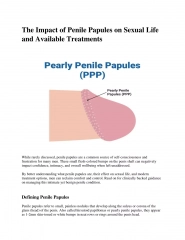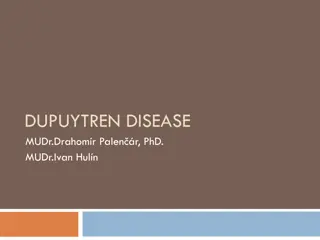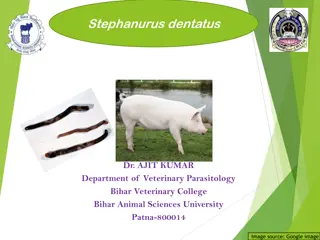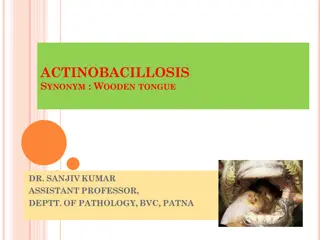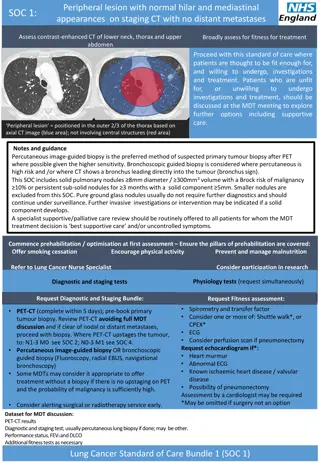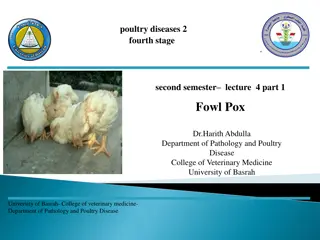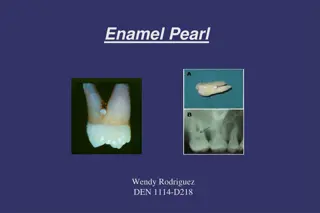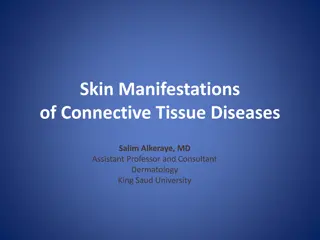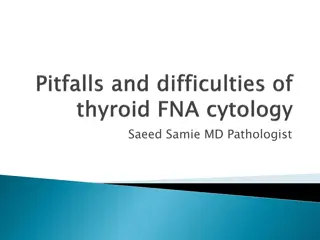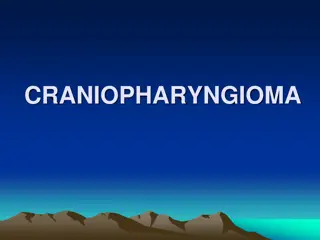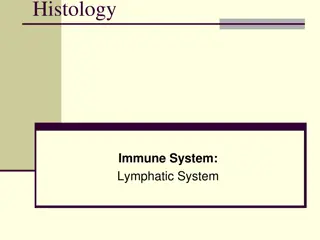Ask the Expert Your Top Adult Circumcision Questions Answered
Penile papules refer to small, painless nodules that develop along the sulcus or corona of the glans (head) of the penis.
1 views • 5 slides
Role of High-Resolution Computed Tomography in Fibrosing Interstitial Lung Diseases
HRCT plays a crucial role in diagnosing and monitoring fibrosing interstitial lung diseases (ILDs). It helps identify abnormalities not visible on X-rays, leading to early, accurate diagnoses and potentially avoiding invasive procedures. HRCT assists in distinguishing specific ILDs based on radiogra
1 views • 25 slides
DUPUYTREN DISEASE
Dupuytren's disease is characterized by fibrotic nodules and bands in the palmar aponeurosis, leading to flexion deformities in the fingers. The etiology is unclear, with higher incidence in Europe. Clinical presentation varies, with treatment options including collagenase injections, needle aponeur
4 views • 11 slides
Understanding Stephanurus Dentatus: Kidney Worm of Pigs
Stephanurus dentatus is a parasitic worm that infects pigs, with an intricate life cycle involving earthworms as transport hosts. Transmission occurs through ingestion of larvae or infected earthworms, leading to various pathological effects, including subcutaneous nodules, cirrhosis, and organ dama
0 views • 13 slides
Understanding Glanders: Causes, Symptoms, and Transmission
Glanders, also known as Farcy, Equinia, or Malleus, is a contagious disease affecting horses, mules, and donkeys. It is caused by the bacteria Pseudomonas mallei and can be transmitted through direct contact or inhalation. The disease manifests with nodules or ulcers in the respiratory tract and on
0 views • 11 slides
Nitrogen Fixation and Symbiotic Relationship in Agriculture
Nitrogen fixation is a crucial process where nitrogen is converted into ammonia by nitrogen-fixing bacteria, benefiting plants like legumes. Symbiotic nitrogen fixation involves a mutualistic exchange between plants and bacteria, exemplified by Rhizobium species. This symbiosis leads to the conversi
0 views • 15 slides
Overview of Cutaneous Tuberculosis: Causes, Classification, and Clinical Features
Cutaneous tuberculosis is caused by Mycobacterium tuberculosis and its manifestations depend on the host's immunity, route of entry, and bacterial load. It is classified into exogeneous and endogenous sources, with various types such as tuberculides and tuberculous chancre. Clinical features include
0 views • 31 slides
Actinobacillosis (Wooden Tongue) in Cattle and Sheep: Overview of the Infectious Disease
Actinobacillosis, also known as Wooden Tongue, is a specific infectious disease affecting cattle and sheep, caused by Actinobacillus lignieresii. It is characterized by fibrosis of the tongue and soft tissues, leading to mobility issues. The disease is primarily transmitted through wounds and abrasi
0 views • 8 slides
Parathyroid Carcinoma Misdiagnosed as Thyroid Lesion: A Case Study
Parathyroid carcinoma (PC) is a rare malignancy often challenging to differentiate from benign thyroid nodules. This case study highlights a 50-year-old male patient whose nonfunctioning sporadic PC was initially misidentified as a follicular thyroid nodule. Despite preoperative evaluations, includi
4 views • 27 slides
Understanding Gout in Birds: Clinical Findings and Management Approaches
Gout in birds is a form of inflammatory arthritis caused by abnormal uric acid accumulation. It can affect both visceral and articular tissues, leading to various clinical findings such as nodules, polyuria, and anemia. Diagnosis involves physical exams, blood tests, and imaging. Treatment focuses o
3 views • 8 slides
Standard of Care for Peripheral Lesion Assessment with Normal Hilar and Mediastinal Appearances
Assessing patients with peripheral lesion on staging CT with normal hilar and mediastinal findings. Further investigation with contrast-enhanced CT is recommended for fitness evaluation and treatment planning. Biopsy methods, diagnostic criteria, and considerations for nodules and nodal staging are
4 views • 5 slides
Understanding Fowl Pox in Avian Species: Causes, Symptoms, and Diagnosis
Fowl Pox, caused by Avipoxvirus, is a contagious disease in birds characterized by wart-like nodules and diphtheritic membranes in the throat and mouth. It has multiple forms, including dry pox, wet pox, and coryza-like form, with varying clinical signs. The disease spreads through mosquitoes, bitin
1 views • 10 slides
Understanding Enamel Pearl Anomaly in Dentistry
Enamel Pearl is a developmental anomaly where small nodules of enamel form below the cemento enamel junction, mainly on permanent teeth. This anomaly, detected radiographically, can lead to bacterial accumulation, periodontal issues, and inflammation if left untreated. Dental hygienists play a cruci
0 views • 8 slides
Skin Manifestations of Connective Tissue Diseases - Lecture Highlights
This lecture series discusses the various skin manifestations of connective tissue diseases, focusing on Lupus Erythematosus and other related conditions. It covers different types of Lupus, its effects on the body systems, treatment options, and psychosocial impacts. Additionally, the presentation
0 views • 76 slides
Insights on Reporting Thyroid Fine-Needle Aspiration as a Pathologist
Pathologist Saeed Samie discusses feelings of safety and satisfaction when reporting thyroid FNA results, emphasizing certainty in malignant lesions over benign ones. Reduction of unnecessary surgical interventions and the importance of uniform categorization for clinical decision-making and guideli
0 views • 9 slides
Endocrine Potpourri: Adrenal Insufficiency and Incidentalomas - Case-Based Review
This endocrine potpourri covers various cases involving adrenal insufficiency, adrenal crisis, adrenal incidentalomas, and patient education. It includes a detailed case presentation, treatment guidelines for adrenal crisis, patient education on adrenal insufficiency, and evaluation of adrenal nodul
0 views • 62 slides
Diseases of Skin Overview and Primary Lesions by Dr. Sonam Bhatt, Assistant Professor VMD Basu Patna
Skin, the largest organ of the body, plays a crucial role in regulating temperature and acting as a protective barrier. It consists of the epidermis, dermis, and subcutis, along with skin appendages like hair and claws. Skin lesions can be categorized into primary and secondary, with primary lesions
0 views • 18 slides
Comprehensive Overview of Craniopharyngioma: History, Pathology, and Treatment Considerations
Craniopharyngioma is a complex intracranial tumor with a rich historical background dating back to the early 20th century. Initially described by McLean, Frazier, Alpes, and famously studied by Cushing, this tumor continues to be a subject of debate and controversy in terms of treatment approaches a
0 views • 76 slides
Understanding the Lymphatic System and Immune Response
The lymphatic system, a vital component of the immune system, consists of lymphocytes, plasma cells, and other cells within a framework of reticular cells and fibers. It includes lymphoid organs like the bone marrow, thymus, lymph nodes, and spleen. Diffuse lymphatic tissue and lymphatic nodules are
0 views • 20 slides
